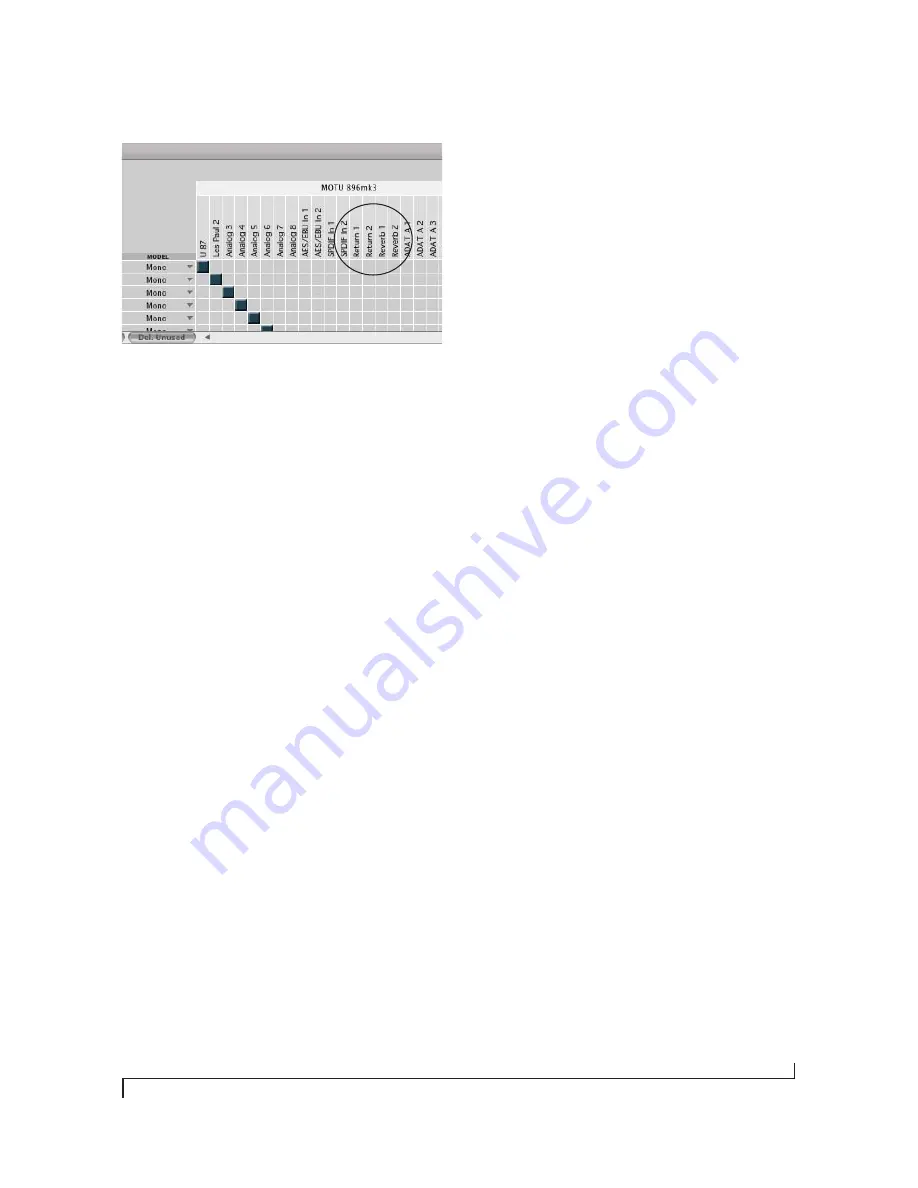
A U D I O D E S K
59
Figure 8-2: The stereo return and reverb return busses from the
896mk3 in AudioDesk’s Bundles window.
☛
Warning: the Return inputs can cause
feedback loops! DO NOT assign this input to a
track that shares the same 896mk3 output pair as
the returns.
Reverb return
The 896mk3 also supplies a return to AudioDesk
that carries the output of its reverb processor
(Figure 8-2). This return can be used for any
purpose you wish.
WORKING WITH 896MK3 INPUTS AND
OUTPUTS
Once you’ve enabled the MOTU FireWire Audio
driver as explained earlier in “The 896mk3
settings” on page 57, 896mk3 audio inputs and
outputs will appear in AudioDesk’s audio input and
output menus. If you don’t see the optical inputs
and/or outputs, check the MOTU Audio Setup to
make sure they are turned on and set to the format
you require. If you don’t plan to use either optical
bank, turn it off to conserve computer bandwidth.
Trimming the analog inputs
The 896mk3 analog inputs provide trim knobs on
the front panel. To calibrate an audio input:
1
Record-enable a track in AudioDesk.
2
Choose the desired 896mk3 input for the track.
3
Open the Audio Monitor window.
4
As you feed signal to the input, adjust the input’s
corresponding trim knob on the front panel of the
896mk3 until peaks in the level meter are as high as
possible without clipping (hitting zero dB).
Phones 1-2
If you’ve chosen to treat the 896mk3 headphones as
an independent output, you’ll see
Phones 1-2
in
AudioDesk’s output menus. Audio tracks assigned
to this output pair will be heard on the headphone
jack only. For further explanation, see “Phones” on
page 58.
24-BIT OPERATION
Your 896mk3 hardware fully supports AudioDesk’s
24-bit recording capabilities, including both
analog and digital 24-bit recording. If you would
like to record and play back 24-bit audio files, go to
the Audio Options in the AudioDesk Preferences
(AudioDesk menu), and choose 24-bit recording
as the sample format for the project. This setting is
saved with the AudioDesk project.
PROCESSING LIVE INPUTS THROUGH
AUDIODESK PLUG-INS
If you patch a live input (such as MIDI synthesizer)
through a plug-in effect in AudioDesk, you might
hear a slight delay. There are several ways to reduce
this delay. For details, see chapter 10, “Reducing
Monitoring Latency” (page 69).
WORKING WITH CUEMIX FX MIXING AND
EFFECTS
The 896mk3 provides powerful external mixing,
EQ, compression and reverb, which you can
operate hand-in-hand with AudioDesk’s complete
mixing environment. For example, the 896mk3
can serve as a monitor mixer routing channels to
musicians, or it can serve as an integrated
extension of your AudioDesk mixing environment.
If you program an 896mk3 mixing and processing
configuration that goes hand in hand with your
AudioDesk project, be sure to use the file save
features in CueMix FX to save the 896mk3 settings
Содержание 896mk3
Страница 8: ...8...
Страница 14: ...A B O U T T H E 8 9 6 M K 3 14...
Страница 16: ...P A C K I N G L I S T A N D M A C S Y S T E M R E Q U I R E M E N T S 16...
Страница 32: ...I N S T A L L I N G T H E 8 9 6 M K 3 H A R D W A R E 32...
Страница 42: ...M O T U A U D I O S E T U P 42...
Страница 68: ...O T H E R M A C O S X A U D I O S O F T W A R E 68...






























